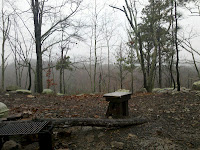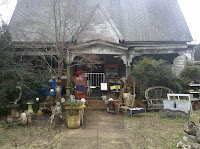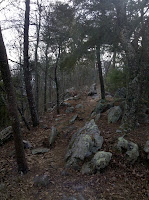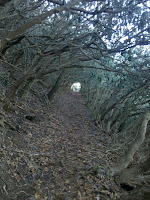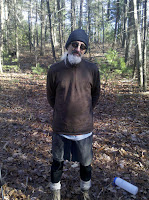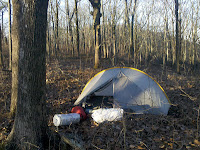 |
| Campsite on the Pinhoti |
 |
| My canister cosy |
Rain gear: The biggest weather problem on this trip has been consistent cold rain with temperatures dropping afterwards and freezing my wet clothes stiff. I knew that no rain gear is completely waterproof but I learned that the biggest problem zone of a rain jacket are the arms. Why is that? I am hiking with trekking poles and using them your hands are in a higher position than your elbow. If it is raining this has the effect that water will slowly run down from your hands and wrists into your jacket soaking the arms of whatever warm layer you are wearing. In hard rain it got so bad that the water even reached my armpits and started trickling down the side of my body. I tried to avoid that problem by cinching close the arms of rain jacket but it did not help at all. The only solution for this kind of situation is NOT to use trekking poles! If your arms are hanging down all the time water will not get inside the arms. But unfortunately the terrain was so rocky that I had to use trekking poles...
Drying clothes: Because of the above mentioned problem I often had to deal with wet clothes and find ways to dry them in cold and wet weather. It did not help to hang them up in the shelters over night. They would drip dry a bit but still be wet. There are two ways to dry them: Smaller pieces that were only slightly wet I dried overnight be wearing them inside my quilt. I used my wind jacket to prevent the moisture of the wet clothes penetrating into my dry insulation. This method worked surprisingly well for damp socks and one piece of wet base layer. I guess it helped a lot, too that I was using a synthetic quilt. I'd be afraid to use this method with a down quilt because down uses its warming abilities when getting damp. But this method only works for one or two pieces of clothing. What to do with the rest? I let the stuff drip dry over night which can have the effect that you wake up and find your clothes frozen stiff. Keep in mind that frozen clothes are much bulkier than dry clothes! I then started wearing the wet stuff dry during the day. This is a slow process as you can only dry one piece at a time. If you wear too many wet clothes at a time you'll just get hypothermic. Again I used my wind jacket as a protective layer for my dry insulation layer.
Sleeping bag/quilt: I have used a synthetic quilt for this trip, the Enlightened Equipment Prodigy 20 quilt. For quite a while I have been very disappointed with down and for this trip down would have been a catastrophe. Almost every night I had to deal with plenty of condensation. When I woke up in the morning the footbox of my quilt was wet from touching the tent walls. And very often the upper part of the quilt was wet from my breathing. With a down sleeping bag moisture would have penetrated into the down, made it clump and the insulating qualities of the bag would have been seriously compromised. Synthetic is so much more robust! The humidity did not degrade my synthetic quilt's temperature rating. My quilt came with 10d Nylon shell fabric which dried surprisingly fast. When I woke up in the morning I turned the quilt inside out and slipped back into the quilt. It took only the time I needed for breakfast to dry the shell fabric through my body warmth. Do not take a down bag/quilt on such a trip. The prolonged exposure to humidity will degrade the down's insulating qualities quickly and you'll be unable to dry it properly. Synthetic is the material of choice for cold and wet climates.
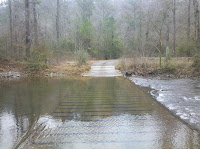 |
| Ford on the Georgia Pinhoti |






